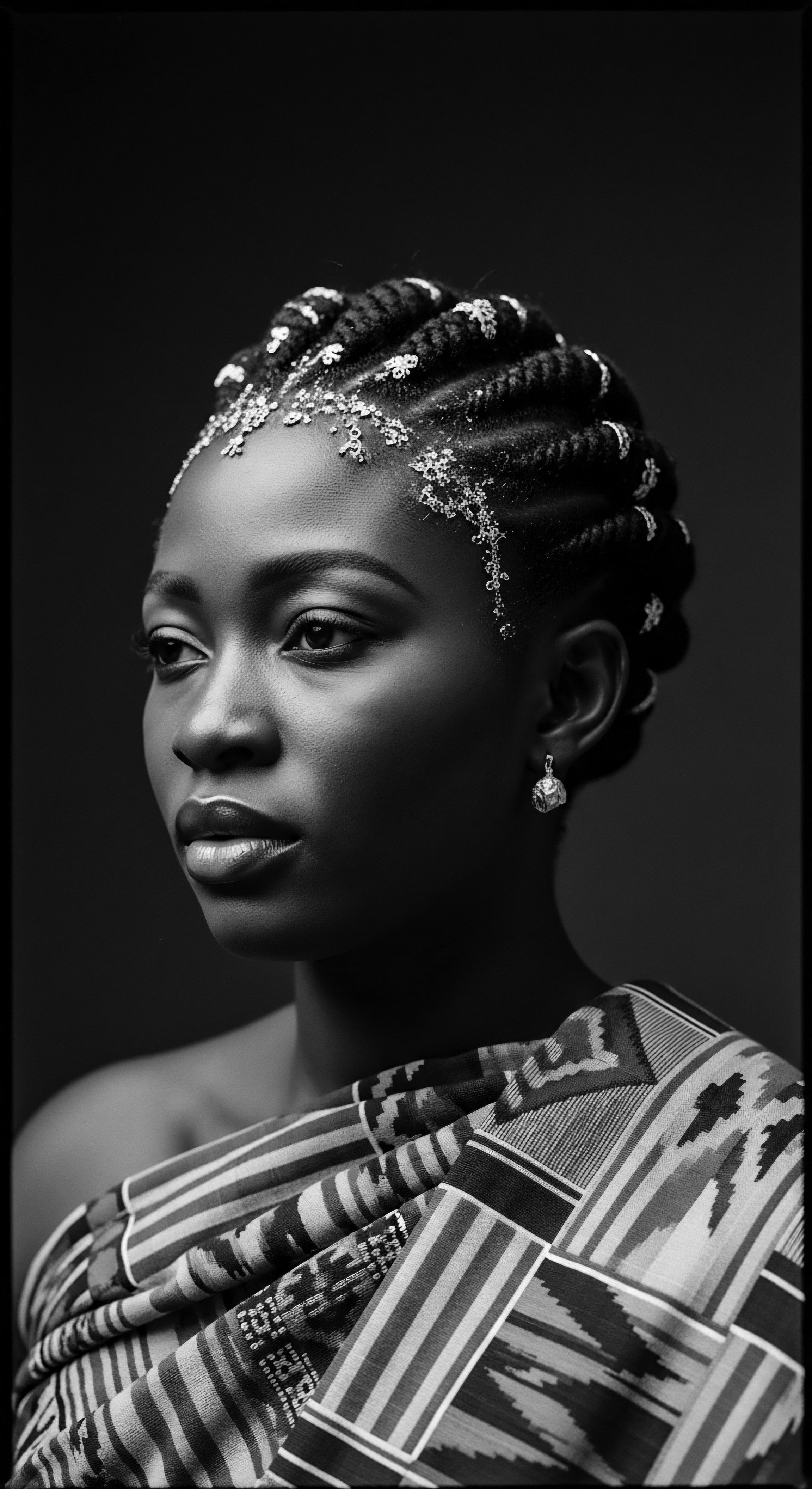
Roots
The story of textured hair, so deeply woven into the lineage of Black and mixed-race communities, holds chronicles of both challenge and triumph. It speaks of ancient traditions, of ancestral artistry, and of an enduring spirit that refused to be dimmed, even when faced with legislative shadows. The Tignon Laws, enacted in late 18th-century New Orleans, stand as a stark example of such shadows, yet their tale is far from one of simple suppression.
These laws, ostensibly about dress and social order, reached into the very soul of a people, attempting to redefine their visual identity and restrict the vibrant expressiveness tied to their hair. For those of us who carry this heritage in our strands, understanding this historical moment reveals layers of resilience and creativity that continue to shape our approach to hair, community, and self.
The Tignon Laws, though designed to suppress the visible beauty of Black and mixed-race women, instead ignited a powerful counter-expression of heritage.
The Spanish colonial governor, Esteban Rodríguez Miró, in 1786, issued an edict that commanded free women of color to cover their hair with a tignon, a simple cloth or handkerchief. This decree, part of a broader set of regulations, aimed to impose a visible distinction between white women and free women of African descent in New Orleans, particularly those who had achieved a measure of economic and social standing. The city at that time was home to a sizable population of gens de couleur libres, free people of color, many of whom were educated, owned property, and conducted successful businesses. Their elaborate hairstyles, often adorned with jewels, feathers, and ribbons, drew considerable attention, challenging the prevailing social hierarchy and, as some historical accounts suggest, attracting white men, much to the chagrin of white women in the colony.

What Did These Laws Attempt to Conceal?
The true motivation behind the Tignon Laws was not merely to regulate fashion; it was a deeply racialized effort to control social mobility and reinforce a perceived subordinate status. These laws sought to visually link free women of color to enslaved individuals, whose head coverings were often practical necessities during labor. The elaborate hairstyles of free women of color were seen as a direct affront to the racial and social order colonial authorities desperately sought to maintain.
The natural textures, the intricate braiding, and the thoughtful adornments of their hair embodied a cultural confidence, a connection to ancestral aesthetics that defied the rigid, oppressive structures of the time. This visible pride was, in itself, a form of soft power, one that the dominant society felt compelled to diminish.

Early African Hair Practices and Their Reverence
Long before the Tignon Laws, in diverse African societies, hair was a profound marker of identity, status, spirituality, and community. Hairstyles conveyed marital status, age, tribal belonging, wealth, and even religious affiliations. For instance, the Yoruba and Igbo women of West Africa fashioned the Gele, an intricate headwrap, often for celebrations, with complexity indicating higher status. In East Africa, headscarves like the Dhoop or Leso often bore patterns and proverbs, embodying wisdom.
- Cornrows ❉ In many African communities, patterns could serve as maps for escape routes during times of enslavement, holding covert communication within their design (Greensword, 2025).
- Braids ❉ Beyond their aesthetic appeal, braids often symbolized family lineage or social standing, their creation frequently a communal ritual.
- Coils ❉ The natural coil of hair, celebrated in many pre-colonial African cultures, represented a connection to the divine, its upward reach toward the sky embodying spiritual aspiration.
When African peoples were forcibly brought to the Americas, they carried these deep-seated understandings of hair with them. Despite the brutality of the transatlantic slave trade, where enslavers often shaved heads in a brutal attempt to strip cultural connection, the knowledge of hair’s significance persisted. The Tignon Laws thus targeted not just a fashion trend but a deeply ingrained cultural practice, an elemental aspect of self that echoed ancient traditions of adornment and identity.

Ritual
The enactment of the Tignon Laws, far from quelling the vibrant expressions of Black and mixed-race women in New Orleans, inadvertently spurred a powerful counter-cultural movement. The decree intended to make these women appear less attractive, to visibly signify their inferior social standing. Instead, what emerged was an extraordinary display of creative defiance, transforming a symbol of oppression into a statement of identity and exquisite style. This transformation became a ritual of resistance, a collective act of reclaiming visible selfhood.
The compelled covering of hair under the Tignon Laws became a canvas for defiant artistry, reshaping the very symbol of oppression into a badge of cultural pride.

How Did the Tignon Shape Public Identity?
The women of New Orleans, particularly the free women of color, responded to the law with an ingenious flourish. They did cover their hair, as mandated, but their chosen tignons were anything but simple or unassuming. They fashioned headwraps from luxurious fabrics, such as silks and fine muslins, and adorned them with jewels, ribbons, and feathers.
These were not acts of meek compliance; they were bold statements, each knot and fold a quiet yet potent act of rebellion. The wraps became elaborate, architectural creations that drew even more attention than the uncovered hairstyles they were meant to hide.
This reinterpretation of the tignon served multiple purposes within the community’s heritage. It became a public declaration of continued self-worth and a subtle mockery of the laws themselves. The creativity displayed in these headwraps showcased the women’s artistry, their economic means (for those who could afford opulent materials), and their unwavering spirit.
Historian Virginia M. Gould observes that Governor Miró had hoped the laws would control women who “competed too freely with white women for status,” yet the result was the opposite ❉ the tignon became a mark of distinction, beauty, wealth, and ingenuity.
| Era and Context Pre-Tignon Laws (Colonial Louisiana) |
| Intent of Law/Societal Pressure Maintain racial hierarchy, limit influence of free women of color. |
| Response and Heritage Shift Elaborate, natural hairstyles with adornments, reflecting African ancestral pride and rising social standing. |
| Era and Context Tignon Laws (1786, Spanish Louisiana) |
| Intent of Law/Societal Pressure Suppress beauty, visibly mark "slave class" via mandated head covering. |
| Response and Heritage Shift Defiant adornment of tignons with luxurious fabrics, jewels, and intricate wrapping styles, making them statements of beauty and resistance. |
| Era and Context Post-Tignon Laws (1803 Louisiana Purchase onward) |
| Intent of Law/Societal Pressure Eurocentric beauty ideals gain prominence, continued racial discrimination. |
| Response and Heritage Shift Headwraps persist as symbols of cultural identity and resistance, even as hair straightening gains traction for assimilation. |
| Era and Context The history of head coverings for Black women reveals a continuous thread of adaptation and resistance, transforming imposed restrictions into symbols of enduring heritage. |

Cultural Adaptations and New Meanings
The power of the tignon lay in its transformation. It was a visible paradox ❉ an enforced uniform that became a canvas for individual expression. This act of turning a mandate into a mode of communication speaks volumes about the deep cultural roots and resilience of the women targeted. They took a gesture intended to humble them and imbued it with pride, a testament to their inherent capacity for beauty and self-determination.
This period also cemented the headwrap’s place within the collective memory of Black American and Afro-Caribbean heritage, solidifying its dual meaning as both a historical marker of oppression and a celebration of enduring spirit. The practice of headwrapping continued long after the Tignon Laws were formally unenforced following the Louisiana Purchase in 1803, solidifying its place as a symbol of defiance and cultural heritage.
The ingenuity of these women finds a modern echo in the CROWN Act, legislation designed to prohibit discrimination based on hair texture or style. This present-day movement reaffirms that hair remains a politically charged aspect of Black identity, a space where battles for self-acceptance and cultural recognition continue to be waged. The spirit that transformed the tignon lives on in today’s calls for hair equality, showing how historical challenges lay groundwork for contemporary movements rooted in the very same quest for dignity.

Relay
The historical reverberations of the Tignon Laws reach far beyond the streets of 18th-century New Orleans, extending into the broader tapestry of textured hair heritage and its complex relationship with identity. These laws were not isolated incidents; they were part of a wider colonial strategy to control the bodies and self-expressions of marginalized groups. The response of Black and mixed-race women to this particular edict, however, stands as a compelling case study in cultural resilience and the power of aesthetic defiance. Their actions laid down a generational blueprint for navigating oppressive systems while preserving ancestral connections.
The enduring legacy of the Tignon Laws demonstrates how systemic oppression against Black hair often catalyzes deeper expressions of cultural identity and ancestral connection.

How Did This Resistance Influence Ancestral Practices?
The Tignon Laws aimed to homogenize and diminish the appearance of free women of color, intending to strip away the visible markers of their prosperity and distinct heritage. Yet, this legislative constraint inadvertently catalyzed a profound re-imagining of ancestral practices. Headwrapping, a practice deeply rooted in various African cultures as a symbol of status, spirituality, and beauty, was compelled into public view. What might have been a private tradition or one worn without specific legal compulsion was now a daily, public obligation.
This shift forced an adaptation, a transformation of the tignon from a simple covering to a deliberate act of artistry. Women meticulously chose vibrant colors, adorned their wraps with symbols and ornamentation, and developed intricate tying methods that spoke volumes without uttering a single word. This became a ritual of resistance, a collective choreography of cultural defiance.
Consider the broader socio-historical context ❉ hair, for centuries in many African communities, served as a non-verbal language, conveying societal status, tribal affiliation, and even marital eligibility. For enslaved Africans and their descendants in the diaspora, hair often became one of the few remaining ties to their heritage, a site of memory and continuity amidst the rupture of forced displacement (Byrd & Tharps, 2002). The Tignon Laws sought to sever this visual language, to silence this form of ancestral communication. Instead, the women re-authored the script, proving that true cultural expression lies not just in overt display but also in the spirit with which a form is inhabited and reinterpreted.
- Ingenious Adaptation ❉ The tignon, a mandated head covering, became a medium for artistic expression, using luxurious fabrics and embellishments.
- Symbolic Transformation ❉ What was intended as a mark of inferiority transformed into a beacon of self-worth and communal pride.
- Enduring Legacy ❉ The practice established a precedent for resistance through aesthetic means, influencing subsequent generations’ approaches to hair and identity.

What Can Science Tell Us About Hair’s Social Context?
Modern sociological and psychological studies often reveal the enduring impact of historical policies like the Tignon Laws on contemporary perceptions of textured hair. The policing of Black women’s hair, a practice that found early legislative form in the Tignon Laws, persists today through various means, from workplace discrimination to school dress codes. A 2019 survey, for example, highlighted that 80 percent of Black women reported feeling compelled to alter their natural hair to conform to workplace expectations.
This statistic illustrates a direct lineage from historical attempts to control Black female appearance to current systemic biases. The aesthetic choices concerning textured hair are rarely, if ever, purely personal; they are deeply intertwined with historical narratives of power, oppression, and resistance.
The science of hair, its diverse textures, and its unique needs, also connects to this historical context. Textured hair, with its unique curl patterns and density, requires specific care to maintain its integrity. Traditional African hair practices, often involving natural oils, plant-based cleansers, and protective styles, developed out of a deep, intuitive understanding of these very biological needs. These practices were cultivated over generations, passed down as ancestral wisdom.
The Tignon Laws, by mandating coverage, did not erase this knowledge but perhaps shifted its public presentation, reinforcing the importance of protective styling even as it restricted outward display. The ingenuity of women who continued to care for their concealed hair, even as they adorned their tignons, speaks to a profound respect for their physical selves and their inherited wisdom.
The ongoing struggle for hair freedom, epitomized by movements for legislative protections like the CROWN Act, stands as a contemporary testament to the unresolved legacies of laws like the Tignon Laws. The historical imposition of head coverings, once a stark legal requirement, has evolved into a societal pressure to conform to Eurocentric beauty ideals, often manifesting as microaggressions or outright discrimination against natural styles. Yet, the resilient spirit that transformed the tignon in 1786 continues to drive a re-claiming of textured hair as a symbol of power, pride, and unapologetic selfhood.

Reflection
The echoes of the Tignon Laws reverberate through generations, settling into the very soul of a strand. What began as a punitive measure, a decree aimed at diminishing the visible brilliance of Black and mixed-race women, transformed into a potent declaration of identity, a canvas for unyielding heritage. The history of the tignon is not merely a chronicle of legal imposition; it is a profound testament to the inherent power of cultural expression to resist, adapt, and ultimately, to define itself.
These women, with their intricate wraps and defiant spirits, did not simply comply; they transcended. They showed the world that true beauty and inherent worth cannot be legislated away, nor can the deep wisdom of ancestral ways be silenced.
Today, as we observe the continuous journey of textured hair through society, we recognize the Tignon Laws as a foundational moment in its narrative. The spirit that turned a mandated covering into a symbol of bold selfhood lives on in every natural curl embraced, every protective style chosen, every headwrap donned with pride. Our hair, in its myriad forms, remains a living archive, a repository of resilience, a continuum of care passed down through the ages.
It reminds us that heritage is not static, but a dynamic force, constantly shaped and re-shaped by both challenge and triumphant spirit. To honor this legacy is to stand in awe of those who came before us, understanding that their quiet acts of defiance paved the path for our unbound helix, our collective journey toward holistic well-being and unapologetic self-acceptance.

References
- Byrd, Ayana, and Lori L. Tharps. Hair Story ❉ Untangling the Roots of Black Hair in America. St. Martin’s Press, 2002.
- Gould, Virginia M. The Devil’s Lane ❉ Sex and Race in the Early South. Oxford University Press, 1997.
- Greensword, Sylviane Ngandu-Kalenga. “Historicizing Black Hair Politics ❉ A Framework for Contextualizing Race Politics.” Sociology Compass, 2025.
- Winters, Ze. The Mulatta Concubine ❉ Terror, Intimacy, Freedom, and Desire in the Black Transatlantic. University of Georgia Press, 2015.
- Mintel Group Ltd. “Black Consumers and Hair Care ❉ US,” 2016.
